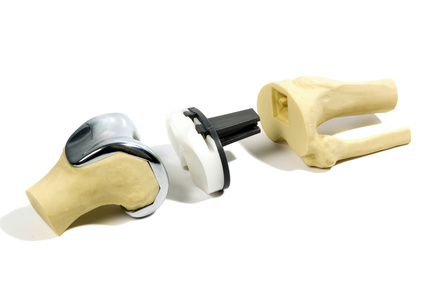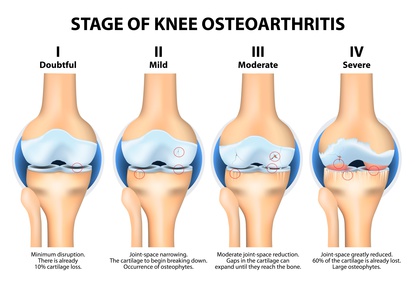Knee Replacement and Physiotherapy
 As our population continues to age and life expectancy increases with many people wishing to keep active longer, there are a growing number of people who will have a knee replacement.
As our population continues to age and life expectancy increases with many people wishing to keep active longer, there are a growing number of people who will have a knee replacement.
Our physiotherapy service sees a great number of people who have had a knee replacement and are in the process of recovering from this surgery. Our home visit physiotherapy service is based in Lichfield and serves surrounding areas such as Sutton Coldfield, Tamworth, Rugeley, Walsall and Cannock. The information on this page tries to give more detail about what is involved with a knee replacement and why physiotherapy is an essential part of the recovery process.
 The knee is made up of 3 bones - the tibia (shin bone) the femur (thigh bone) and the patella (knee cap), in essence it is a hinge joint with femur articulating with the tibia below and this joint bearing most of the load. The patella is a sesamoid bone (the largest in the body) and is situated in the quadriceps tendon and helps connect the 4 muscles of the front thigh (the quadriceps) to the tibia below. Inside of the knee joint and (as with all joints) between the tibia and femur is cartilage which reduces friction and improves shock absorption, in the knee however unlike other joints there are two special semi circular fibro-cartilage rings called the menisci. These sit on the tibial plateau beneath the femur and help the femur to fit neatly onto the tibia below and also aid greatly with shock absorption. Inside of the knee joint itself are two key ligaments, the anterior cruciate ligament (ACL) and posterior cruciate ligament (PCL) which stop excessive forward and back movement of the femur/tibia. The patella itself has cartilage on its underside which reduces friction between the patella and femur underneath. Finally there are two ligaments either side of the knee - the medial and lateral collateral ligaments.
The knee is made up of 3 bones - the tibia (shin bone) the femur (thigh bone) and the patella (knee cap), in essence it is a hinge joint with femur articulating with the tibia below and this joint bearing most of the load. The patella is a sesamoid bone (the largest in the body) and is situated in the quadriceps tendon and helps connect the 4 muscles of the front thigh (the quadriceps) to the tibia below. Inside of the knee joint and (as with all joints) between the tibia and femur is cartilage which reduces friction and improves shock absorption, in the knee however unlike other joints there are two special semi circular fibro-cartilage rings called the menisci. These sit on the tibial plateau beneath the femur and help the femur to fit neatly onto the tibia below and also aid greatly with shock absorption. Inside of the knee joint itself are two key ligaments, the anterior cruciate ligament (ACL) and posterior cruciate ligament (PCL) which stop excessive forward and back movement of the femur/tibia. The patella itself has cartilage on its underside which reduces friction between the patella and femur underneath. Finally there are two ligaments either side of the knee - the medial and lateral collateral ligaments.
 Phew, glad the anatomy lesson is over now! So, how does all of the above relate to having a knee replacement and recovering from it? Well firstly if you are going to get it replaced it seems reasonable to know some of the basics of what you are getting replaced. Secondly it helps with understanding the process that leads to needing a replacement knee- osteoarthritis. As described earlier inside the knee joint is cartilage - this is inside every moving joint of the human body and is present whenever bone moves over bone. Cartilage reduces the amount of friction in the joint and aids with shock absorption - in good health cartilage will look like a smooth ice rink when examined under arthroscopy. However as we age this cartilage starts to wear out, it begins to get pitted and holes develop in it. This in turn leads to inflammation, increased load on the bones and as this process carries on bony spurs called osteophytes may develop. This overall process is called osteoarthritis (often shortened to OA) and is the main reason for a knee replacement. A reasonable question at this point would be: "If osteoarthritis is a process of wear and tear of the cartilage - why doesn't everyone need a knee replacement at some point?" Well, that is a difficult one to answer and the underlying reasons are still being investigated - currently it is thought that genetics play a large role. For instance if your mother, grandmother and aunt etc have all had a knee replacement at 70, there will be a high likelihood that you will need a joint replacement at some point. High BMI (Body Mass Index) has also been linked to arthritis and certainly it makes sense that if you put more load through a joint it will wear out quicker.
Phew, glad the anatomy lesson is over now! So, how does all of the above relate to having a knee replacement and recovering from it? Well firstly if you are going to get it replaced it seems reasonable to know some of the basics of what you are getting replaced. Secondly it helps with understanding the process that leads to needing a replacement knee- osteoarthritis. As described earlier inside the knee joint is cartilage - this is inside every moving joint of the human body and is present whenever bone moves over bone. Cartilage reduces the amount of friction in the joint and aids with shock absorption - in good health cartilage will look like a smooth ice rink when examined under arthroscopy. However as we age this cartilage starts to wear out, it begins to get pitted and holes develop in it. This in turn leads to inflammation, increased load on the bones and as this process carries on bony spurs called osteophytes may develop. This overall process is called osteoarthritis (often shortened to OA) and is the main reason for a knee replacement. A reasonable question at this point would be: "If osteoarthritis is a process of wear and tear of the cartilage - why doesn't everyone need a knee replacement at some point?" Well, that is a difficult one to answer and the underlying reasons are still being investigated - currently it is thought that genetics play a large role. For instance if your mother, grandmother and aunt etc have all had a knee replacement at 70, there will be a high likelihood that you will need a joint replacement at some point. High BMI (Body Mass Index) has also been linked to arthritis and certainly it makes sense that if you put more load through a joint it will wear out quicker.
 So, you are going to get a knee replacement... what can you expect? Well, to some extent this will depend on the hospital that you go to and in general they will have given you a fair amount of information about what to take and how to prepare - so we will probably leave this bit and jump straight to after the operation. On waking up I think it would be reasonable to expect to be sore! This is a major orthopaedic operation and your knee will be very swollen, painful and in a large dressing. Ward staff and physiotherapists will be keen to get you up and mobilising on day one post-operation if at all possible, usually you will use a frame initially and then progress down to crutches. If you have stairs at home the physiotherapist will want to check that you are able to use a set of crutches on the stairs and have safe technique. On a busy hospital ward you are likely to see a physiotherapist once a day and on average you should expect to be in hospital at least 3 - 5 days before being sent home where ideally you will see a community physiotherapist or attend an out-patient clinic.
So, you are going to get a knee replacement... what can you expect? Well, to some extent this will depend on the hospital that you go to and in general they will have given you a fair amount of information about what to take and how to prepare - so we will probably leave this bit and jump straight to after the operation. On waking up I think it would be reasonable to expect to be sore! This is a major orthopaedic operation and your knee will be very swollen, painful and in a large dressing. Ward staff and physiotherapists will be keen to get you up and mobilising on day one post-operation if at all possible, usually you will use a frame initially and then progress down to crutches. If you have stairs at home the physiotherapist will want to check that you are able to use a set of crutches on the stairs and have safe technique. On a busy hospital ward you are likely to see a physiotherapist once a day and on average you should expect to be in hospital at least 3 - 5 days before being sent home where ideally you will see a community physiotherapist or attend an out-patient clinic.
 Physiotherapy is an essential part of the recovery process from a knee replacement and this is the point at which a home visit physiotherapy service such as ours really comes into its own and can help you recover as quickly as possible. The first few weeks are a critical period in your recovery and ideally you will see a physiotherapist several times a week for mobility practice, strengthening exercises, stretching and working on the range of motion of the joint.
Physiotherapy is an essential part of the recovery process from a knee replacement and this is the point at which a home visit physiotherapy service such as ours really comes into its own and can help you recover as quickly as possible. The first few weeks are a critical period in your recovery and ideally you will see a physiotherapist several times a week for mobility practice, strengthening exercises, stretching and working on the range of motion of the joint.
As you begin to improve and your range of motion at the knee increases the number of sessions with your physiotherapist will slowly reduce - as at this point you should be able to walk independently, have good range of movement at the joint and be working through an exercise programme. As you improve further over the following months is its essential that you have regular reviews with your physiotherapist to assess progress, discuss any problems and modify your exercise programme in order to best achieve your goals. It is vital that you continue with your exercises and physiotherapy throughout your recovery and it is best to think in terms of approximately 6mths to a year to achieve a full recovery, throughout which you will need access to physiotherapy.
ThreeSpires Physiotherapy provides patients who have had a knee replacement a way to access regular, high quality physiotherapy without the necessity of visiting an out-patients clinic which especially in the first few weeks can be very difficult and painful. With our service you can have the optimal number of sessions per week of physiotherapy at home in order to maximise your recovery. If you have had a knee replacement via the NHS (as the majority do) then due to budget constraints it is unlikely that you will receive the optimum number of sessions per week, in which case our service can supplement the NHS provision and enable you to make better progress.
Due to the complexity of the problems that knee replacement patients face, the need to clearly determine any protocols from the surgeon and the lengthy assessment process; treatment sessions are 1 hour for all sessions including follow ups. It is our experience that this extended period of time allows for a much greater benefit and response to therapy and is especially beneficial for patients who are in significant pain and benefit from a slower and more progressive approach to rehab.
So if you have had a knee replacement and want to improve your recovery and would like home visit physiotherapy, then please do get in touch, we are a home visit physiotherapy service based in Lichfield and serving surrounding areas such as Burntwood, Cannock, Tamworth, Sutton Coldfield, Walsall, Rugeley and Cannock. You can call us on 0788 428 1623 email us at enquiries@threespiresphysiotherapy.co.uk or alternatively use the contact form
REQUEST A CALLBACK
Just fill in the form below and give us a quick idea of your problem/request so that we can be better prepared to help you.
